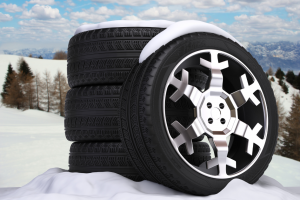Don’t Get Caught Slipping: How to Handle Winter Like a Pro
As the days grow shorter and the temperatures drop, it’s important to adjust how you care for your tires. The transition from summer to winter is one of the most critical times for tire maintenance, as seasonal changes bring entirely new driving conditions. Here’s how to make sure your tires are ready for the colder months and winter roads.
1. Replace Summer Tires with Winter Tires

From summer sunshine to winter snow: Is your vehicle ready for the seasonal shift?
Summer tires are built for warmer weather and aren’t suited for the icy, slick conditions that winter brings. The rubber compounds in summer tires harden as temperatures drop, making them less effective at gripping cold surfaces. Winter tires are designed to remain flexible even in freezing conditions, improving traction on snow and ice.
Why Winter Tires?
- Better traction: Winter tires have deeper grooves and specialized tread patterns designed to cut through snow and ice.
- Safety: Cold temperatures make summer tires unsafe even if there’s no snow, as they don’t perform well below 7°C (45°F).
If you’re unsure about investing in winter tires, check out our post on Why Do You Need Winter Tires? for a detailed breakdown of their benefits.
Our recommendation for Canadian drivers: Continental IceContact XTRM
2. Check Tire Pressure Regularly

Don’t wait for the snow—check your tire pressure regularly to maintain grip and safety on winter roads.
As temperatures fall, so does your tire pressure. For every 10°C (18°F) drop in temperature, your tires lose about 1-2 PSI. Low tire pressure can lead to decreased fuel efficiency, uneven tread wear, and a higher risk of blowouts.
How to Prepare:
- Monitor tire pressure weekly. This ensures optimal grip on icy roads and helps maintain vehicle stability.
- Fill your tires to the recommended PSI, which you can find in your vehicle’s manual or inside the driver’s door frame. Don’t forget that under-inflated tires can be especially dangerous in slippery conditions.
Read more: Understanding Tire Pressure
3. Inspect Tread Depth

Ensure your tread depth is winter-ready—deep grooves like these provide better traction on snow and ice.
Winter roads demand more from your tires, and tread depth plays a critical role in how well they can handle snow and slush. Tires with insufficient tread depth are prone to losing grip, increasing the risk of accidents due to sliding or hydroplaning.
How to Prepare:
- Test tread depth with a simple coin. Place a quarter into your tire’s tread groove. If you can see the top of the queen’s crown, it’s time to replace the tire.
- Rotate your tires if the tread is unevenly worn. This ensures that each tire wears evenly, improving performance and prolonging their life.
4. Consider Winter Wheels

Get ready for the cold: Winter wheels and tires offer better handling and durability on icy roads.
For those who live in areas with extreme winters, winter wheels can be an excellent investment. They are specifically designed to accommodate winter tires and provide better overall handling during harsh winter conditions.
Benefits of Winter Wheels:
- Preserve your all-season or summer wheels. Switching between dedicated winter and summer wheels extends the life of both sets.
- Quick changes: Winter wheels make seasonal tire changes faster and easier.
Want to learn more? Explore The Benefits of Winter Wheels for a detailed explanation of why they could be a smart addition to your winter car care routine.
5. Proper Tire Storage for Off-Season Tires

Proper tire storage helps extend the life of your off-season tires, keeping them in top condition for when you need them next.
Once you’ve swapped out your summer or all-season tires for winter tires, make sure your off-season tires are stored properly. Improper storage can lead to tire deformation, cracks, and a shortened lifespan.
How to Store Tires:
- Clean your tires before storage to remove any debris that could cause deterioration.
- Store tires in a cool, dry place away from direct sunlight. A tire storage bag or airtight container can help prevent cracking and UV damage.
For more tips, check out our post on Why Should You Use Tire Storage?
6. Electric Vehicles: Winter Tires Are Even More Important

Winter readiness for electric vehicles: Ensure your EV’s tires are prepared for the cold months ahead.
Electric vehicles (EVs) present unique challenges when it comes to winter driving. EVs are generally heavier than traditional cars due to their large battery packs, which means they put more strain on the tires, especially in cold weather. This makes winter tires even more essential for EVs.
How Winter Tires Impact EVs:
- Extra Weight: The added weight of an EV demands tires with better traction to handle snowy and icy conditions.
- Battery Efficiency: Cold weather affects battery efficiency, and tires with low rolling resistance, like winter tires, can help maintain efficiency during winter.
- Instant Torque Handling: EVs deliver power instantly, which can cause tires to lose grip more easily, especially on slick surfaces. Winter tires provide the necessary traction to handle this torque safely.
Switching to winter tires can significantly improve the safety and performance of your electric vehicle in winter weather, so don’t overlook this important step. For more info, check out our post Navigating the Chill: Tips for Using Your Electric Vehicle in Winter
Final Thoughts
The change from summer to winter demands more from your tires, and proper preparation ensures both safety and performance. By switching to winter tires, checking your tire pressure, and maintaining adequate tread depth, you’re taking the necessary steps to stay safe on the road. For additional safety tips as we approach the holidays, read our post on How to Drive Safely This Holiday Season.
